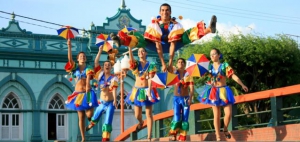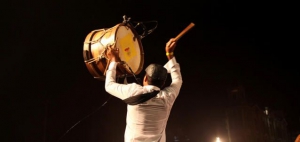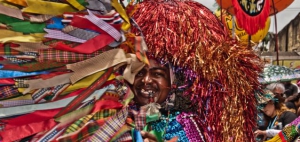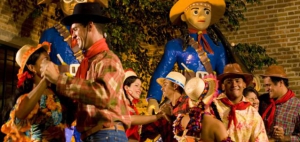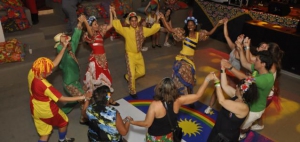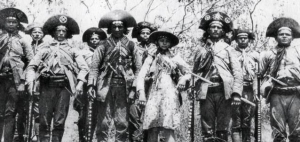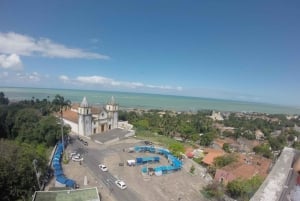Culture in Pernambuco
Pernambuco has a rich multicultural blend to offer is visitors, brewed in the course of centuries of mixing Indians, Portuguese, Africans, Dutch, British, French, Spaniards and many more peoples, each bringing a unique contribution to this tropical bouquet of rhythm, flavours and traditions.
Not an overstatement: Pernambuco's carnival has the most abundant display of genuine cultural manifestations. Frevo, Maracatu, Caboclinhos, and many others cross the same streets during the four official days of the party, which makes it unique in all of Brazil.
Declared an Intangible Cultural Heritage of Mankind by Unesco, the Frevo music and dance had a humble origin. It was born in the late 19th century, from the encounter of the martial bands' fanfare (playing polka, salsa and other tunes) and the slave's capoeira dance. The acrobatic moves were performed so quickly to the pace of the drums and brasses that is was said they were at boiling point ("ferver", hence, "frevo").
As it is with many art forms, at first it had issues with the law: capoeira dancing was a matter dealt with by the police, which is why as soon as they appeared the dancers would change and disguise their moves, thus originating the modern frevo steps.
Frevo today presents three distinct varieties:
Frevo de Rua (Street Frevo)
Orchestrated frevo, without lyrics. The fast paced tunes are performed by marching bands, with distinctive quick percussion and piercing brasses. This is the rhythm to which dancers perform their footwork and summersaults, sporting colourful clothes and a small umbrella which helps them to keep balance.
Frevo Canção (Song Frevo)
Also played on the streets and with the help of an orchestra, but the melodies have anthem-like lyrics (a tradition inherited from Rio de Janeiro).
Frevo de Bloco
Performed with wooden and string instruments (guitars, banjos and mandolins) and a female choir. It first appeared in bourgeois districts, before being influenced by street frevo, carioca marches and the "jornada pastoril" (read below).
The umbrella name "maracatu" is used to describe two musical traditions, which have different origins and souls, but share the taste for heavy percussions and visual exuberance. Rehearsals and performances go on all year around in the country and in the city, but the biggest display of both style is undoubtedly during Carnival.
Maracatu Nação
Also known as the "Maracatu do Baque Virado", the "Maracatu Nação" tradition is related to habits of the African slaves brought to Brazil and the Afro-Brazilian religion of Umbanda. The dancing performance re-enacts coronations in African courts, while the drums and other percussive instruments give praise to the deities of Umbanda. Therefore, it is considered more than an artistic performance: it is also a religious ritual.
Maracatu Rural
The "Maracatu Rural", began, as displayed in its name, in the countryside of Pernambuco, in the sugarcane fields, where it is until today a strong tradition. Also called "Maracatu do Baque Solto", it combined a myriad of other local traditions until it arrived to its lavishing current outcome: a fast-paced rhythm, combining percussion and poetry. The dancers are a spectacle on their own: rugged rural men, covered from head to toe by enormous and colourful costumes, with a spear on their hands and a flower in their lips.
Mangue beat
In the 1990s, Recife's music underwent an energetic renovation, which is still unparalleled today. Groups such as Chico Science & Nação Zumbi and Mundo Livre S/A craftily combined the centennial rhythms of maracatu with the globalized sounds of rock, pop and hip-hop. The result was the "Mangue Beat" (or Bit) movement, an aesthetical outcry which propelled the sounds from Pernambuco across the globe, and at the same time renewed the local's interest in grassroots music.
The abundant plumage dancers wear when performing the "Caboclinho" gives away where this tradition comes from. It is inspired in the warrior dances of the native Indians, which also explains the quickness and vigour of the moves performed to the sound of the leaders whistle, plus flutes and percussions. The "Caboclinhos" are one of the highlights of Pernambuco's Carnival.
Though this holiday is known all across Brazil, the Northeast is the region where "São João" is most enthusiastically celebrated. This is one of the many European heritages which seem to have been best kept in the Northeast's countryside. "São João" came to Brazil with the Portuguese Court, and over time it mixed its continental features with local characters and habits.
The "quadrilhas", for example, are lively group dances with dozens of participants. Its origins date back to French Courts, as hinted by the shouts of "anavantu" ("en avant tous") and "anarriê" ("en arrière") which coordinate the steps. The costumes and clothing worn during the party, however, represents typical characters from the countryside: herdsmen, landlords, brides, bandits and soldiers.
Some of the typical symbols of "São João" are large bonfires, small and colourful flags used in decoration, fireworks and all varieties of corn-based food. "Canjica", "munguzá", "pamonha", "paçoca" and "bolo de milho" are some of the local treats which will make you miss Pernambuco.
Though "São João" is celebrated all across the State, it is Caruaru that upholds the title for the biggest commemoration. Up to 1 million people go to the city to join the party, which goes on for about 30 days.
Forró
This dancing rhythm is immediately associated with "São João", but on the rest of the year it is also played extensively. One of the reasons for "forró" to be so popular (particularly among young people) is that it is an simple and upbeat dance for couples. If you've never danced to a similar tune, two steps left - two steps right should keep you safe.
"Forró" in its classic form originated in the countryside. Its instruments are the accordion, the "zabumba" (large leather-topped drum) and a triangle. While the drum marks the pace, the accordion provides the harmony and the triangle sprinkles sharp, metallic notes all across the tune to keep you moving. This simple formula produces a catchy rhythm which keeps couples dancing on and on at the "arrasta-pés".
More modern spin-offs have come about in recent years, coming mostly from urban areas. Their innovation was the introduction of electric instruments and departure from the traditional song motifs (the hardships of the arid countryside) to more contemporary, irreverent matters. "Electric forró", as it is known, is particularly popular among young people in Pernambuco.
The towering figure of "forró" and other rhythms from the Northeast (such as "xaxado" and "baião") is Luiz Gonzaga. Born in 1912 in Exu (600 km from Recife), Gonzaga was responsible for making the sounds of his native region well known across Brazil, besides updating and reinventing many of them with his rich, unmistakable compositions. His life has recently been converted into a feature film in 2012, in commemoration of the 100 years of his birth.
In most places, giving hands and gently dancing in a circle is something people stop doing when they stop being children. In Pernambuco, it is a thing for grown-ups too. The "Ciranda" is a slow-paced group dance, accompanied by percussion, wind instruments and chanting, in which participants join hands and swing to and fro. Circles can get pretty big, at which point they will break to form a smaller circle within the larger one. The most famous "Ciranda" in the State is the one carried out by Lia de Itamaracá, on the North Coast.
The "Coco", in turn, is influenced by both African and Indigenous dances, and it is also danced in circles (though other forms are possible). Like "Ciranda", it is a popular rhythm along the Coast of the Northeast region, although it is much more energetic.
Bumba-Meu-Boi
The "Bumba-Meu-Boi" or "Boi-Bumbá" tradition is found everywhere in Brazil, and in Pernambuco it became more associated with Christmas. During that time of the year, it is performed mainly as a play, with a plot revolving around a bull, herdsmen, a landlord and his slaves. The "Bumba-Meu-Boi" character is present in other seasons, such as Carnival and São João, but instead of acting it mostly parades and dances. The typical outfit (a colourful bull-shaped barrel you can wear strapped over your shoulders) is a popular souvenir, specially among children.
Pastoril
This Christmas play started out holy and arrived to the present day profane. It came through Spaniards and Portuguese, who back in medieval times made of Nativity re-enactments an important tradition for telling the story of the Saviour's birth to the masses. Quite early in colonisation, this habit was introduced in Brazil by the Jesuit priests.
Somewhere along the way, the holiness gave way to humour, and piety to puns. Also, instead of just being a play, "Pastoril" became a sort of duel. The actresses portraying the Bethlehem shepherds were divided in two opposing parties: one dressing red and the other blue, while a neutral figure, Diana, stood between them.
This tradition is still today well spread across the Northeast and is a part of the Christmas celebrations. Today it is no longer as irreverent and edgy as in the beginning of the 20th century, consisting mainly of a spectacle of singing and choreography.
Reisado
Another European heritage, the "Reisado", also known as "Festa dos Reis", is the tropical version of what Iberians did since the middle ages on early January: have a host of curious characters walking from door to door announcing the birth of Jesus Christ.
In the Northeast, this tradition absorbed the local idiosyncrasies and characters. Most importantly, it is sung and danced to the sound of local rhythms and poetry, which make it another welcoming street display of artistic ingenuity. It traditionally takes place from December 24 to January 6 ("Dia de Reis").
Though home to many revolutionary heroes, Pernambuco also takes pride in some of its villains. One character which made its way into the collective imagination is Virgulino Ferreira da Silva, aka "Lampião" (Portuguese for "Oil Lamp"). How he inherited such an alias is also revealing of his line of work: tradition says he tampered his rifle so that it would fire faster, producing big bursts of light, resembling a lamp.
"Lampião" was a "cangaçeiro", a type of bandit which emerged in the drylands of the Northeast in turn from the 19th to the 20th century. While some "cangaçeiros" worked as private armies for powerful landlords, others made a living out of attacking towns, farms and warehouses, not to mention stealing from and kidnapping rich people. They would travel from place to place, running away from police and army forces. These outlaws were easily recognizable by their characteristic trappings: all-leather clothes (including large bicorn hats) with coins stitched.
The "cangaço" lore is a recurring subject in manifestations of popular culture, such as the Cordel poetry, and even films, like "O Cangaçeiro" and "Deus e o Diabo na Terra do Sol". This is also why "Lampião" (and his wife-in-arms, "Maria Bonita"), though known for his cruelty, became overtime an icon for some rugged values cherished in the Northeast, such as bravery and honour. His home city, Serra Talhada, and Triunfo, a favourite destination of his band, both host a museum about the "cangaço".
* Photos by Evaldo Parreira and EMPETUR.


